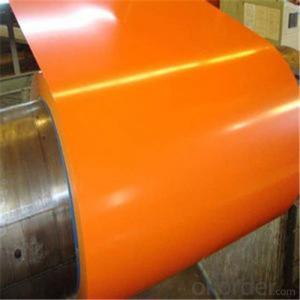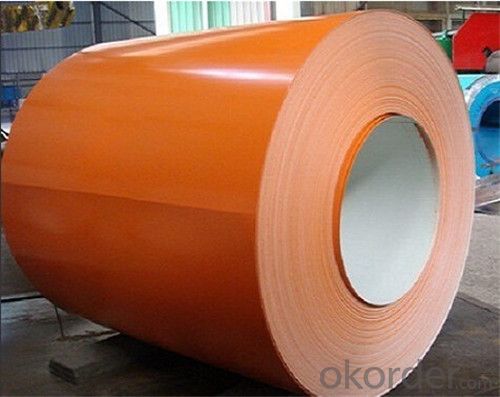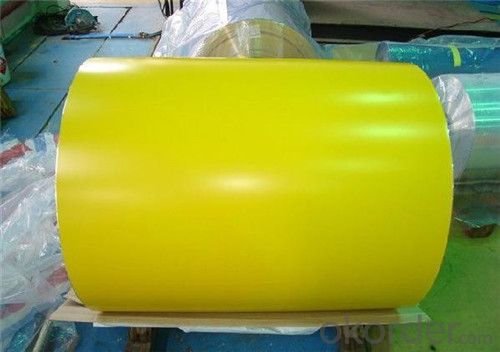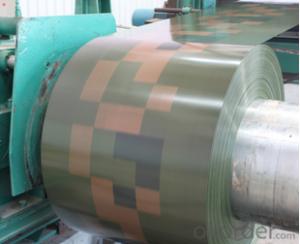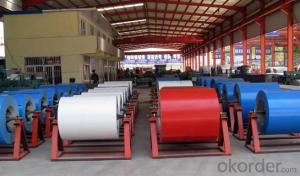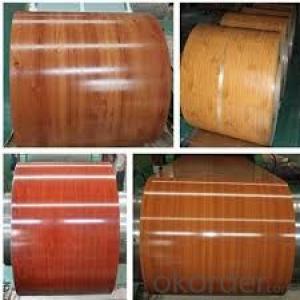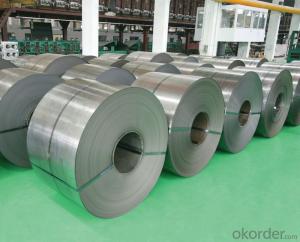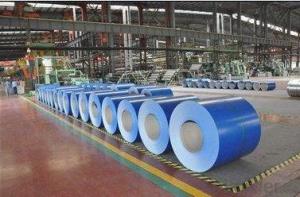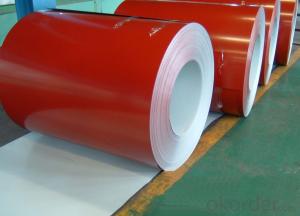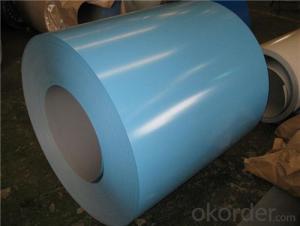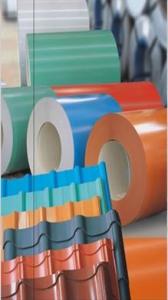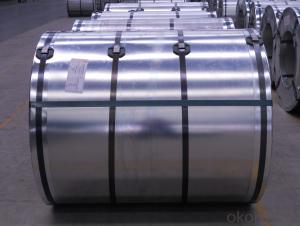Color Coated Galvanized cold Rolled Steel Coil
- Loading Port:
- Tianjin
- Payment Terms:
- TT OR LC
- Min Order Qty:
- 20 m.t.
- Supply Capability:
- 30000 m.t./month
OKorder Service Pledge
OKorder Financial Service
You Might Also Like
Color coated hot rolled steel coil takes hot-dip galvanized steel coil asits basic material. Factory adopts the newest technologies and the mostadvanced equipments to degrease, rinse, chemical transform the cold-rolledsteel coils or galvanized steel coils. Then we make primary and refined lavation
for the steel strips. We use worldwide advanced solidify furnace to solidify the coasting surface.This kind of color painted coils has excellent capability of decoration, molding,
corrosion resistance ability. It keeps the products with color coatings inflamboyant color for a long time.Nowadays, it has become the most perfect building materials in construction, transportation,
manufacture, light industry, office furniture, household electric appliances,
food package, and other areas all over the world.
Features:
1) Thickness: 0.2 - 1.5mm
2) Width:<1250mm< span="">
3) Lacquer: according to customer's needs
4) The color-coated steel coil is produced by hot-galvanized steel and color-coated with the paint produced according to the American standards
5) The combining force between the galvanized steel and the paint is very strong
6) The surface is polish
7) Coat fabric 2/2 (two coats for top / two coats for bottom)2/1 (two coats for top / single coat for bottom)1/1 (single coat for top / single coat for bottom)
8) Colors: white, black, sky blue, bright red, yellow
9) Can be used in building material field, galvanized wire steel tape and all other fields.
- Q: How are steel coils processed for painting or coating?
- Steel coils are typically processed for painting or coating through a series of steps. First, the coils are cleaned to remove any dirt, oil, or rust. This is usually done through a chemical cleaning process or by using mechanical methods such as shot blasting. Next, the coils are pre-treated to enhance adhesion and corrosion resistance. This can involve applying a conversion coating or a primer. Finally, the coils are painted or coated using a variety of methods such as roll coating, spray coating, or electrostatic coating. The specific process depends on the desired finish and application requirements.
- Q: What is the role of steel coils in the production of industrial machinery?
- Steel coils play a crucial role in the production of industrial machinery as they serve as the raw material for various components and parts. The coils are often used to fabricate structural frames, gears, shafts, and other essential elements that provide strength, durability, and stability to the machinery. The versatility and strength of steel make it an ideal material for withstanding the rigorous demands of industrial applications, ensuring the reliability and performance of the machinery.
- Q: What are the different types of steel coil packaging?
- There are several types of steel coil packaging, including steel strapping, stretch wrapping, shrink wrapping, and wooden crates.
- Q: What is the type of stainless steel used in knifes.
- If your talking about a folding pocket knife, I think that it's basically six one way and a half dozen the other. I actually do prefer stainless for my pocket knives. I don't want to oil a knife to the degree I feel carbon requires, only to then stick it my pocket to attract dirt to the knife and oil to my pants. I'm the exact opposite on sheath knives though. I like 1095 carbon steel, plain edge sheath knives. I'll thrash on them HARD, and I rarely have major edge problems. Of course, I require them to be coated with some kind of powder coat or the like, because they can rust, but I do try and keep them clean and dry when in the sheath, so they won't pit the uncoated edge. My reasons for this sheath knife preference is multi-fold. First, these knives are simply affordable. I don't spend $80 dollars on a outdoors sheath knife. I use the tool too hard to want to spend more. I don't like the more traditional stainless steels such as AUS-8, 420HC, and 440C (not to mention the HORRENDOUS 440A) because I feel that the all else being equal, a stainless blade will bend before a carbon blade will break. I also think that carbon holds an edge at least as well, if not better, than traditional stainless, and it's much easier to hone. I don't know much about these new laminates, other than the very hard, but not so tough. They seem to be POSSIBLY too brittle for my use. That, combined with the fact that they cost a FORTUNE, means that I just won't be considering them.
- Q: What are the common coil thickness and width combinations available for steel coils?
- The specific requirements and standards of the industry can cause the available combinations for steel coil thickness and width to vary. Nonetheless, there are commonly used combinations that can be found. There is a range of options for coil thickness, varying from thin to thick coils. Thin coils typically have a thickness of 0.4mm to 3.0mm, while medium thickness coils can be around 3.0mm to 6.0mm. Thicker coils can range from 6.0mm to 25.0mm or even higher, depending on the specific application. The coil width also varies depending on the intended usage. Common options include widths of 600mm, 750mm, 900mm, 1000mm, 1200mm, 1250mm, and 1500mm. However, wider or narrower coils can also be available depending on the specific requirements of the customer or industry. Ultimately, the most suitable combination of coil thickness and width will depend on factors such as the intended application, manufacturing processes, transportation limitations, and customer preferences. It is crucial to consult with steel coil manufacturers or suppliers to determine the most appropriate options for your specific needs.
- Q: How are steel coils used in the production of containers?
- Steel coils are used in the production of containers as they are the primary material for manufacturing container bodies. These coils are shaped and welded into the desired container shape, providing strength and durability to the final product.
- Q: i need the same kind of body jewelry they use in the piercing shop but when i go to order them they say stainless steel, not surgical steel, and i have REALLY sensitive skin so i need to be sure, whats the difference?
- There are hundreds of different grades of stainless steel. Jewelery used for piercings should be made of implant grade. Note that the term surgical steel is not a technical term. It doesn't mean anything, although it sometimes refers to what is technically implant grade stainless. Implant grade stainless steel must conform to the ASTM standard 316LVM F-138-00, otherwise the seller cannot call it implant grade. This is something you should always ask about specifically. Are your stainless items F-138-00 compliant? Jewelry that only claims to be stainless isn't good enough. Jewelery sold in mall stands are typically nickel plated, bargain-basement low grade stainless. Allergies to nickel are common.......BUT there is a big difference between allergies, and infections. Infections are caused by bacteria, not by the metal itself, and if you're getting infections it's a sign you're not keeping the piercing clean and sanitary. Simply switching to a different metal won't prevent infections from recurring. To prevent infections you need to take steps to keep new piercing clean and sanitary. the best way to do this is rinse with 50:50 hydrogen peroxide and water daily, then apply some neosporin. hope this helps.
- Q: steel of beam has been rusted ,how can i repair it?
- The rust needs to be removed by what ever means works best for your situation.. Often a twisted wire wheel on a 4 1/2 angle grinder works quickly... a hand wire brush may work well for you, or just plain sandpaper and a LOT of elbow grease (hard work) will remove the rust. From there, a coat of primer paint made for steel. Any hardware store in your area would have such a primer, in quart cans or spray cans. Once that is dry (a good 24 hours for most formulations), you can spray or brush paint the beam most any color you wish.. I've had very good luck with acrylic enamel paints for such projects.. IF your steel is badly pitted, you should consider getting it inspected to insure it will still hold up or support what ever it was installed to do. If you want a smooth finish, once the rust removal is done, you can fill in the dips and pock marks with an auto body filler (Bondo is one brand name)... It comes in 2 parts (the main filler and a hardener) that are mixed well and used to fill in the holes and divits with a plastic spreader.. Once hard (in a few minutes with most brands of filler), sanding with sandpaper and a sanding block will smooth out the finish very nicely. From there, the same primer mentioned above and paint will finish up your project... Hope this helps some... Good Luck!
- Q: I know that the steel is significantly harder than when air cooled, but why is the quenched steel harder?
- When steel is slowly cooled, lots of carbon diffusion takes place because it is not very soluble in steel at room temperature. The carbon is in solution at high temperatures, and is rejected out of the lattice as it cools. And when this happens, the microstructure will consist of ferrite and pearlite, and the lattice structure will be base centered cubic (bcc). If it is cooled fast enough, then the carbon gets trapped in the interstitial sites of the lattice and distorts it to a body centered tetragonal (same as bcc, but elongated in one direction) This elongation strains the lattice and makes it harder. Also, when cooled fast enough the atoms do not have time to diffuse like they normally would and they shear into place. This forms the hard phase of martensite that is desired of heat treated steel. But then it must be tempered back some because it is too brittle.
- Q: Can steel coils be coated with magnetic materials?
- Yes, steel coils can be coated with magnetic materials.
Send your message to us
Color Coated Galvanized cold Rolled Steel Coil
- Loading Port:
- Tianjin
- Payment Terms:
- TT OR LC
- Min Order Qty:
- 20 m.t.
- Supply Capability:
- 30000 m.t./month
OKorder Service Pledge
OKorder Financial Service
Similar products
Hot products
Hot Searches
Related keywords
